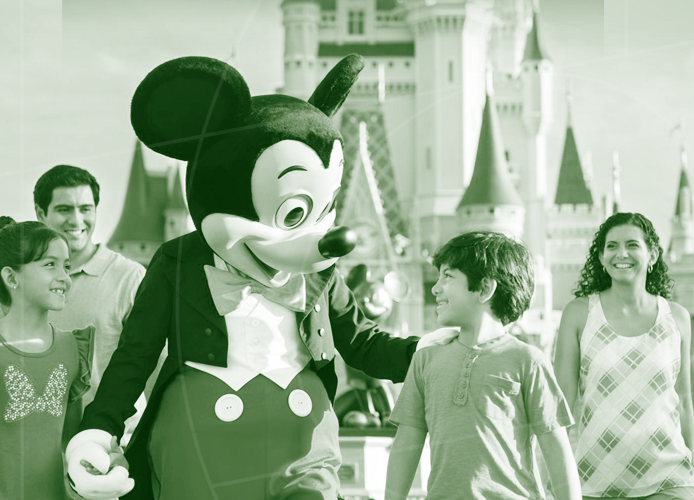

A theme park, Disneyland for example, is a collection of themed lands and attractions that are in form of a dramatic theme and used as a thematic plan for an amusement park. The main characteristic of a theme park is "theme", a concept that distinguishes it from an amusement park. Just as the application of themed design turns a restaurant into a themed restaurant or a game center into a themed game center, theme parks are also the result of a thematic design that is applied to amusement park and its various spatial entertainments. In fact, theme park allows the guest to become a part of the story. A layer of storytelling and theming is added to rides so that it is no longer a simple roller coaster, but unlike books or movies, guests can reach out and touch the facade of Fairy tales’ Castle. Guests at a theme park can dine inside a submarine down in the depth of an ocean or talk and interact with their favorite fictional characters. A theme park is not dependent on rides, while rides are the main factor of an amusement park. A theme park without rides is still a theme park, but an amusement park without rides is a parking lot where sells popcorn!
Finally, themed design not only includes a theme park, but hotels, restaurants, cafes, bars, and cruise ships that are designed based on a unique theme.

Theme park History
Pleasure gardens
The history of parks as places of pleasure goes back to ancient times, but the first permanent park designed for recreational activities can be traced back in the middle ages, with the opening of various pleasure gardens across Europe, such as Vauxhall Gardens. These gardens created a green and fantasy area with sculptures that unlike public parks, focused on entertainment by building gardens, walkways, labyrinths, sculptures, artworks, pavilions, animal performance, concerts, fireworks, ball games and holding parties and recreating events like the Battle of Waterloo.
World’s fairs
In 1851, a great exhibition was held at the Crystal Palace in Hyde Park, London. In addition to education and entertainment, it showcased the industrial achievements of several countries and provided an opportunity for colonized countries to showcase their territories by recreating their architecture and environment. These lands exhibition created the first example of theme parks in the world.
Trolley parks
During the 1800s, a new form of amusement attraction emerged in the form of trolley parks, recreational areas built or funded by railroad companies at the ends of railroad tracks to encourage people to use their railroads.
Kiddie land
Kiddie lands were small theme parks ranged from small amusement parks to themed lands to provide entertainment for children. They mainly recreated fairy tale stories and houses in story books. One of the most successful children's land is Santa Clause Land in Indiana, which is themed around Christmas.
Amusement parks
The largest trolley parks began to establish as amusement parks. Coney Island introduced its location as the first real amusement park. This was accompanied by themed attractions such as a trip to the moon at Luna Park and mechanical attractions such as merry-go-round, tunnels of love and the first dark rides, as well as more unusual attractions such as dwarfs village, an incubator and exotic shows.

Theme parks
Which one is the world's first theme park? It is a controversial issue. Knott's Berry Farm claims to be "America's first theme park." Although it eventually became a theme park by 1940, it offered no more than shops and restaurants! Santa Clause Land is another park claiming to be the first; at least it deserves title of the first children's theme park.
Disneyland can be considered the third rival and certainly the first place purposefully built as a theme park. The term "theme park" was coined in 1958 specifically to describe Disneyland (1955) and the new type of themed entertainment it offered. In trade publications of the time, the term "Disneyland-style Park" was widely used, indicating the scale of Disneyland was Its main difference with other amusement parks and themed attractions of that time. Whether Disneyland was the first theme park or not, its opening revolutionized theme park industry and gave it a new definition.
Adopted from “Theme Park Design & the Art of Themed Entertainment”